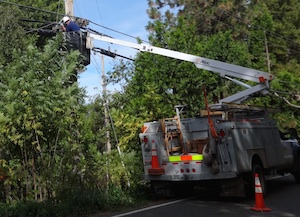
Hanging out, but not hanging fiber.
With the Comcast mega-merger officially dead, the next big deal in line for federal review is AT&T’s proposed purchase of DirecTv. The buzz is that regulators don’t have the same concerns and the expectation is that AT&T will get a green light. The odd thing, though, is that the idea that the deal will improve rural broadband seems to have caught on in Washington.
AT&T sent a letter (h/t to the Eldo Telecom blog for the pointer) to the FCC claiming that consumers would see faster broadband speeds if the deal is approved because off-loading video delivery onto satellite will free up wireline bandwidth and that, somehow, the deal will make fiber-to-the-premise (FTTP) service economically feasible for two million more homes. Competition from cable companies and Google mean that fiber-to-the-node (FTTN) isn’t working for AT&T any more…
These harsh competitive realities were the principal driver of AT&T’s 2014 decision to accelerate its long-term upgrade strategy to extend its fiber deployment all the way to the premise, particularly in those markets where competitive realities require it. FTTP facilitates a better, more compelling set of products, and AT&T expects FTTP to have a longer economic lifespan than FTTN and other prior wireline network technologies. Accordingly, as described in the record, AT&T concluded that it needs to invest in FTTP, where it is economically feasible to do so, to meet customer demand and compete with Cable DOCSIS 3.1 and Google Fiber.
Except that the “markets where competitive realities require” fiber all the way to the home aren’t in rural areas. In fact, AT&T hasn’t put much effort into building even FTTN networks in those markets. It’s the affluent and dense high-potential neighborhoods where competitive realities meet marginal revenue potential.
AT&T is correct in saying that it needs more fiber to stay competitive in the broadband market for the long term. Don’t be fooled, though, into thinking that means it’ll upgrade either decaying rural copper networks or low capacity FTTN systems in low income communities.
